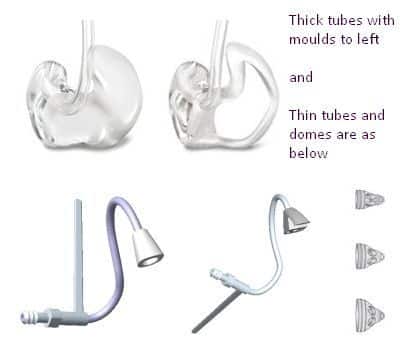As a busy supplier of hearing aid accessories we are asked every week by our customers for advice on swapping a BTE (behind the ear) hearing aid from thick tubing to thin tubing, can we help, can we advise, what tubes need to be ordered, what size, what type of dome etc etc.
If you are reading this page it’s probably because you have asked that question yourself of us.
 You may be wearing hearing aids supplied by the NHS, examples as below;
You may be wearing hearing aids supplied by the NHS, examples as below;
Phonak Nathos Auto, Nathos Nova and all their variants
Oticon Oticon Spirit Synergy, Engage and all their variants
Danalogic and ReSound iFit and Ambio and all their variants
Signia Contrast, Stretta and all their variants
You may have inherited one of the above, been given one of the above by a friend or relative, or even purchased one of the above on eBay. (It’s against their rules to sell hearing instruments on eBay by the way, as well as being an audiologically unsound way to source hearing instruments). Also, it’s worth noting that although NHS hearing aids are freely available here in the UK, they are supplied on loan and should not be sold on eBay or any other platform, they are the property of the NHS. If no longer needed they should be returned to an NHS audiology department.
All that aside…. you have ended up with a hearing aid with thick tubing as per the image above, or maybe a hearing aid with no thick tube and mould, and no thin tube and dome.
You need some way to address your need, to get your hearing aid working to your satisfaction, to hear better.
If you are wearing a hearing aid that already has thick tubing and a mould – to change that hearing aid from thick tubes to thin tubes a number of things need to happen – a hearing professional needs to assess you and your type and level of hearing loss. It’s quite probable that you have thick tubing and a mould because that is the best solution for your type and level of hearing loss, and that particular solution may be the most audiologically sound.
It may be that you were wrongly supplied with thick tubing and a mould and that thin tubes are actually appropriate (less likely but possible). That is not something we can advise on.
IF thin tubes are possible and suitable for your type and level of hearing loss and the hearing aids you are currently wearing we STILL do not know what size and type of thin tubes you’ll need, or for that matter the size and type of dome you need.
There are too many aspects that are unknown at our end to be able to give you any advice, and if you purchased any tubes or domes you really would be guessing at what MIGHT work, the sizes and types of tubes and domes would be absolute guess work, and on top of that the programming of the hearing aid would reflect a thick tube fitting, the programming would be wrong giving an incorrect output. Any tubes and domes supplied by us can not be returned for credit due to hygiene considerations either.
If you have a hearing aid with no thick tubing and no thin tube – please see the above advice, we have no idea what size of tube you would need, or for that matter the size and type of dome you would need. We do not know if thick or thin tubes are most appropriate. You need to be assessed by a local hearing professional who can decide the correct type of tubing, whether thick or thin, and if thin tube the type and size of dome.
If the hearing aid is NHS supplied the only people that can deal with the instrument is NHS audiology, NHS hearing aids are locked to all but NHS personnel.
OUR ADVICE – ask your local hearing professional to assess you, if thin tubes are appropriate for you and your hearing aids, once you are fitted with the correct items then by all means come back to us for spare and replacement parts – once you know what works for you.
